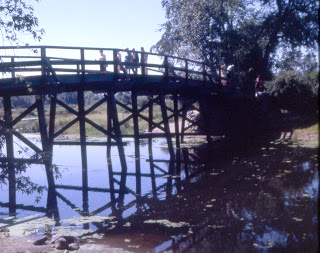- Featuring places connected with my own family history.
- Highlighting places with happy memories.
- Shining the spotlight on place names that appeal.
- Linking my interests in history, travel and photography.
Join me on this journey from A-Z
C is for:
CARLETON is a small hamlet in the parish of Poulton-le-Fylde, Lancashire and the location of my ancestral home - Trap Farm - and here it is!
 |
| Trap Farm, c.1998 |
My great, great grandfather Henry Danson and family were living there in 1841 when the population of the village was 378, and my great grandfather James Danson was born there in 1852.
I set out to find it on a visit to the Fylde c.1998. Situated amidst fields on what is now a busy road, it was a sorry sight - dilapidated and overgrown.
I set out to find it on a visit to the Fylde c.1998. Situated amidst fields on what is now a busy road, it was a sorry sight - dilapidated and overgrown.
In the 1841 Census, 30 year old Henry Danson was living there with his wife Elizabeth (Calvert), five daughters - Betty, Grace, Mary, Margaret and Ellen, his much older brother Peter and two servants.
Ten years on, it was a household of 13. Henry was described as a farmer of 31 acres. Eldest daughter (now married) Elizabeth was there with her three sisters and her husband Thomas Bailey, whilst second daughter Grace had left home. But there were now two sons - John and Henry, plus Henry's (senior's) brother Peter and two servants. How did they all fit into what looked a small farmhouse?
By the time of the next census in 1861 the Danson family was no longer at Trap.
A few years ago I returned to Carleton, fully expecting Trap Farm to be wiped off the map and replaced by a modern housing estate. To my surprise it was still there, but was undergoing a transformation into a modern home.
CAMBRIDGE, Massachussetts - I was lucky enough to work in Cambridge for a year on an exchange programme at Radcliffe College Library. In particular I loved the different architectural styles, from the New England clapboard houses to the gracious buildings of Harvard University.
 |
| Looking across the Charles River to Harvard University |
 |
| The home in Cambridge of poet Henry Wadsworth Longfellow (1807-1882) |
The house, built in 1759, was owned first by John Vassal a British sympathiser who fled at the
onset of the Revolution in 1775, making the residence available to General George
Washington and the Continental Army. Washington and his wife, Martha, lived
there until April 1776; Benjamin Franklin and Abigail and John Adams were among
their house guests.
In 1843, the father of Longfellow's bride, Frances Appleton, purchased the home as a wedding gift for the new couple. The Longfellows and their six children occupied the house for almost forty years and entertained such house guests as Ralph Waldo Emerson, Nathaniel Hawthorne, and Charles Dickens. Here Longfellow wrote many of his poems, including "The Midnight Ride of Paul Revere" and "Song of Hiawatha."
Tragedy befell the household one night in 1861 when a candle accidentally set Frances's dress on fire, injuries from which proved fatal. Longfellow mourned her in the poem "The Cross of Snow," beginning "In the long, sleepless watches of the night,written in 1879.
They came three thousand miles and died,
To keep the past upon its throne:
Unheard, beyond the ocean tide,
Their English Mother made her moan.
Also in Concord was Orchard House, the family home of Louisa May Alcott, (1832-1898), writer of "Little Women" and its sequels. It has always remained in my memory as one of my favourite childhood books, with feisty Jo, arty Amy , homemaker Meg and sad Beth. So I was delighted to visit the house where it was written and imagine Louisa's life there with her three sisters on whom the book was based.
Join me on the next stage of my A-Z Journey as we look at D.
Copyright
© 2013 · Susan Donaldson. All Rights
Reserved




I'm so pleased the house was restored and no doubt another family is enjoying living there. Very special. I didn't get enough time in Concord when we visited, maybe there'll be a "next time". What a pleasure to have the opportunity to live overseas for a while. Thanks Susan.
ReplyDeleteI'm glad the house was restored too. It's so sad to find old homes falling down.
ReplyDeleteThank you, Pauleen and Kristin, for your comments. Yes, I was delighted to find the Trap Farm first time round, though saddened at its state, but it was amazing to see it was still there and being restored, as so much of the surrounding area had been built upon. I would love to have known what the attic might have held!
ReplyDelete